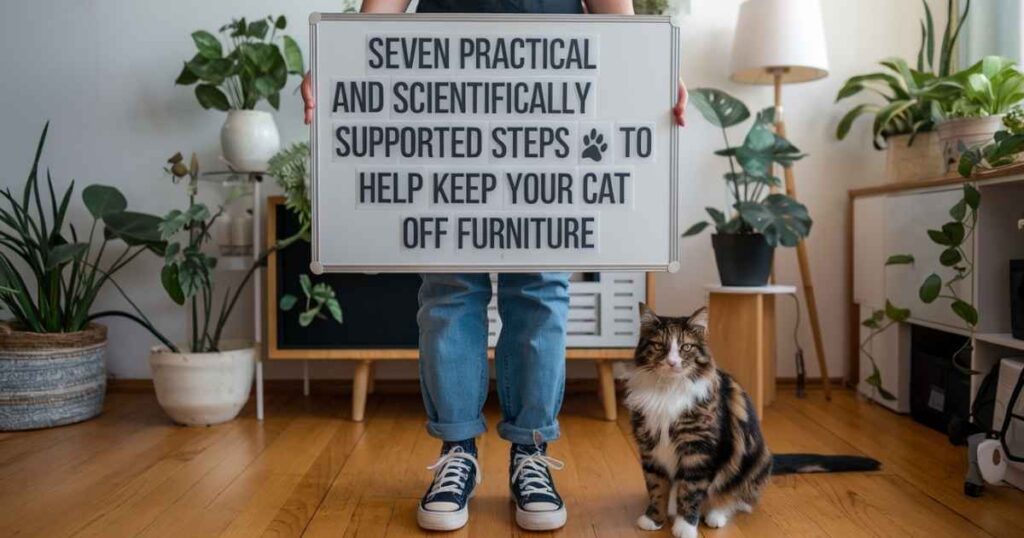Cats are lovable pets that bring joy to our lives, but they can also cause trouble. They love scratching furniture, jumping on countertops, and finding cozy spots around the house. Their curiosity and climbing skills make it hard to keep them off certain areas.
If you’ve ever found your cat on top of the fridge or on your favorite chair, you might wonder if they can be trained. The good news is, with patience and simple tricks, you can guide them toward better habits. You’ll protect your furniture while keeping your cat happy.
Long-Term Solutions for Keeping Cats Off Furniture
When it comes to keeping cats off furniture in the long run, a mix of routine, environmental enrichment, and consistent training is essential. Establishing a daily routine, like regular play sessions and feeding times, helps reduce boredom and anxiety, which are often the root causes of unwanted furniture climbing.
By providing vertical spaces, such as cat trees or wall-mounted shelves, you satisfy your cat’s natural desire for height and security, giving them a safe, elevated spot away from your furniture.
Interactive toys and puzzles keep their minds engaged, reducing the temptation to explore your furniture out of boredom. Consistent positive reinforcement is key to reward your cat for using their designated spaces with treats or praise.
If the problem persists, consulting a veterinarian or a cat behaviorist might uncover underlying issues that need addressing. By combining these strategies, you create a balanced environment that meets your cat’s needs while keeping your furniture cat-free, ensuring a peaceful coexistence in your home.
Is Scratching the Source of the Issue?

An activity for the pet owners to do Pet owners should start by figuring out why their cats are damaging the furniture. If you have a cat, consider these three key questions:
- What are they scratching?
- When are they doing it?
- How are they scratching it?
Here are the reasons for their behavior:
- Sharpen Claws: Scratching helps keep claws sharp and healthy by removing the old layer.
- Marking Territory: Cats leave their scent on surfaces through their paws, making them feel secure in their space.
- Stretching Muscles: Scratching lets cats stretch and stay limber.
- Boredom or Stress: When cats are bored or stressed, scratching helps them release pent-up energy.
- Emotional Expression: Cats scratch to show their feelings, whether they’re excited or anxious.
- Mood Boost: Scratching triggers happy chemicals in their brain, boosting their mood.
- Energy Release: It’s a way for cats to use up extra energy and stay active.
- Prevent Nail Overgrowth: Regular scratching helps keep their nails from getting too long.
Also Read : Warning signs your cat is crying for help
Tips On How To Keep Cats Off Furniture
Dealing with a cat’s scratching can be a real challenge for pet owners. Their sharp claws can easily damage various materials like fabric and leather. To keep your furniture safe from scratches, there are some effective strategies you can try.
| Tip | Description |
| Trim Your Cat’s Nails | Regular trimming keeps nails sharp and reduces scratching damage. |
| Use Citrus Scents | Citrus smells repel cats; use sprays or peels to deter them from furniture. |
| Apply Double-Sided Tape | Cats dislike the sticky texture; place tape on furniture edges to discourage scratching. |
| Provide Scratching Posts | Offer scratching posts near furniture to give cats an alternative and encourage use. |
| Use Plastic Mats | Place plastic mats on furniture to create an uncomfortable texture and discourage scratching. |
| Try Aluminum Foil | Cover surfaces with aluminum foil to repel cats with its crinkly texture and noise. |
| Utilize Vinegar Spray | Spray a mixture of vinegar and water on furniture; cats dislike the strong smell, which deters them from scratching. |
| Consider Store-Bought Sprays | Use commercial cat deterrent sprays designed to repel cats from furniture with effective scents or ingredients. |
Seven Practical and Scientifically Supported Steps to Help Keep Your Cat off Furniture

To keep your cat off furniture, try seven practical steps: provide attractive alternatives like cat trees, use deterrents like citrus sprays, reinforce good behavior with treats, make furniture less appealing with textures like foil, establish a playtime routine, create vertical spaces, and consult a behaviorist if needed. These strategies, backed by science, help redirect your cat’s natural instincts effectively.
Trim Your Cat’s Nails
To reduce scratching, keep your cat’s nails trimmed. Long nails can lead to more aggressive scratching, but trimmed nails are less damaging. You can trim them yourself when your cat is calm.c
Use Citrus Scents
Looking for ways to keep your cat off the furniture? Citrus scents are a natural option, as cats typically hate the smell. Spraying lemon or orange citrus on furniture or other surfaces can help repel them, but it’s wise to test the spray on a small area first to avoid damage.
Citrus oils like lemon and orange are too strong for a cat’s sensitive nose, making them effective deterrents. Applying citrus sprays or placing peels around your furniture can discourage scratching and create a pleasant-smelling barrier that keeps your cat away.
Apply Double-Sided Tape
Using double-sided tape on furniture is a simple way to deter cats since they hate the sticky feel on their paws. It makes scratching uncomfortable and helps train them to stay away from those spots. You can find specialty tape at most pet stores for this purpose.
Provide Scratching Posts
Giving your cat scratching posts provides a dedicated spot for them to scratch instead of your furniture. Place the posts near areas they usually target for easier access. Over time, this helps redirect their scratching to the posts.
Use Plastic Mats
If scratching posts or pads work for your cat, consider adding plastic mats to your furniture as an extra deterrent. Many cats dislike the feel of car mats or the nubs found on plastic carpets. These textures make it uncomfortable for them to walk or settle on these surfaces.
There are also mats specifically made for this purpose, featuring small, safe plastic spikes. The uneven texture discourages cats from climbing or scratching those areas, helping to protect your furniture. Simply place these mats on couches, chairs, or tables to make those spots less appealing for your cat.
Try Aluminum Foil
Aluminum foil effectively keeps cats off furniture because they dislike the crinkly texture and noise. Covering surfaces with foil makes them less appealing to cats. This simple method helps train your cat to avoid those areas, protecting your furniture over time.
Utilize Vinegar Spray
For a budget-friendly DIY solution, vinegar spray is effective at deterring cats. Mix vinegar with water in a spray bottle and apply it to the areas you want to protect. The strong smell repels cats without harming them.
You can adjust the vinegar-to-water ratio based on how strong you want the scent to be. Using diluted vinegar is usually just as effective and less overpowering. If you already use vinegar for cleaning, this method adds extra protection for your furniture.
FAQs
How to keep a cat away from furniture?
Use deterrents like citrus scents, double-sided tape, and scratching posts.
What smells deter cats from furniture?
Citrus and vinegar scents effectively repel cats from furniture.
How can I train my cat to stay off furniture?
Use deterrents like double-sided tape, scratching posts, and store-bought sprays to train your cat to avoid furniture.
Conclusion
Keeping cats off furniture can be managed with a few simple strategies. Use citrus scents, double-sided tape, and scratching posts to redirect their behavior. With a bit of patience and consistency, you can protect your furniture and keep both you and your cat happy.







